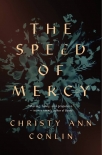The Speed of Mercy Christy Conlin (ebook reader 8 inch .txt) 📖

- Author: Christy Conlin
Book online «The Speed of Mercy Christy Conlin (ebook reader 8 inch .txt) 📖». Author Christy Conlin
“She’s pretty. But I haven’t heard her music.”
Cynthia puts the record on. She picks up a paint brush, holds it to her lips pretending it’s a microphone. She seems to know all the words; she twirls, singing about rolling, falling and roaming in the night. Stella read Emily Brontë’s Wuthering Heights, out loud with her mother, over Christmas last year.
Cynthia picks up the needle and the music stops. “I’m my mother’s favourite subject. She taught me how to use a camera.” Cynthia points at the photos and paintings of herself everywhere in the studio, and a few of Sally that Cynthia took. Cynthia opens a window to let some fresh air into the warm space, a bit of sea breeze mixing into the faint linseed oil scent. Pictures of Cynthia when she was a baby, a toddler, a little girl, school photos from when she had gone to actual school. Pictures of the two of them in Paris and Toronto and New York and Florida, Hawaii and Alaska and Vancouver. Photos of the two of them skiing. Photos of Cynthia playing a trumpet, at the piano, at a harp, Cynthia in her running clothes holding medals. It seems either Frank or Sally had taken most of the photos. Hardly any with all three of them.
A wall cabinet full of volumes on painting. Stella looks at a book about Egon Schiele, pages of nudes, erotic poses. Cynthia is at her shoulder. They giggle. The people seem to be melting, made of wax, left in the sun, buttocks drooping, bodies draping over each other.
“My mother started taking art classes when I went away to school. Here’s her artist statement.” Cynthia hands it to Stella.
Sarah Windsor
My earlier work was romantic and gentle, but then I began to explore deeper themes in the everyday, substantial archetypes and elements present at a core level in both object and setting, which were dominant in a sense of light and natural arrangement. Elements that challenge us to understand inherent danger in everyday moments, the juxtaposition of tender and harsh, a reflection of the destructive forces inherent in nature, in humanity — that a simple flower can also be deadly.
“I thought her name was Sally?”
“It’s the old-fashioned nickname for Sarah,” Cynthia explains. “She uses her real name for her artwork. Windsor is her maiden name. It made my dad so totally mad.”
Stella can’t imagine having a mother who thinks these things. Stella now wonders if her own mother thought this way, if this was why she was drawn to poetry, if it was a place for her to compare all the beauty in her life with all the disappointment. Stella hands the artist statement back to Cynthia and looks at the wall covered with paintings — elaborate botanical paintings, six square canvases of giant peony heads, with a watery background, faces in the flowers and in the water, but if you look again, it seems to be only texture. Paintings of a kitchen and laundry room, a playroom, but in every painting a disturbing aspect — shears left on the floor beside the toddler playing with the stuffed panda. A candle burning perilously low on the wooden bedside table beside the sleeping child.
Stella smiles. “I can’t wait to meet your mom.”
“My dad doesn’t really approve of Mom’s work.” Cynthia faces the southern window, the sun pouring in, and then she turns and runs out the door and down the stairs, calling to Stella as she flies. Stella waits a few moments, breathing in Sally Seabury.
“Stella, are you coming?” Cynthia stands outside the carriage house with her hands on her hips as Stella carefully comes down the stairs.
Stella follows Cynthia towards the house. The weather vane on the top of the carriage house squeaks. Cynthia looks up. “That’s a mermaid up there. Pretty far from home, don’t you think? Everything around here needs to be fixed. Come on, Stella.”
The girls skip to the rear of the mansion, where Cynthia stops and clears her throat, and becomes a strange goth tour guide:
“Please note that this mansion was built eons ago by some forefather of Cynthia’s, a lady apple farmer and her husband who came over from Ireland. The gentleman enjoyed his wife’s love of the agrarian life and her fanciful fixation on the old ways. The house is rundown, inside and out, because the scion, Franklin Seabury IV, hasn’t hired groundskeepers for the last two years. Sheep used to graze out back but they were sold off three years ago, too much, Franklin thinks, for his elderly mother, Mrs. Aoifa O’Cleary Seabury, the grand dame of the property who still resides here at the age of ninety-three, with her granddaughter, Cynthia Aoifa Seabury, who has refused to go back to boarding school, abandoned by her mother.
“Note the heritage plaque by the front door. Champlain explored this area, the famous French explorer, who you may or may not have heard of. Probably you have because you’re a nerd and I mean that as a compliment . . . anyway, Champlain was friendly with the Acadian settlers and the Mi’kmaq who called the Valley Kespukwik.” Cynthia inhales, holds her breath and then lets out a puff of air. “Like, my father would want me to be a tour guide. As if.”
“Wow, you know so much history.”
“From Granny Scotia. But these days she has some trouble remembering things, more day-to-day stuff, like what year it is and who’s who, the seasons and stuff. Sometimes. Not all the time. She never used to but now she does. Don’t tell anyone. Dad doesn’t have patience with old people. My mother says it’s how he deals with his emotions. He says she reads too many self-help books.
“The house was in Granny Scotia’s family. Matrilineal, left to the daughters. Granny says it was unusual then and it still is now. It will be mine someday, not my dad’s. He’s not happy about that. There’s a lot of land,





Comments (0)